
Полная версия
Home Baking
5. Hold a long, sharp knife at the top of the baking sheet and tilt it at an angle towards you with one hand on the handle and the other at the top of the blade. Very carefully pull the knife towards you, scraping the chocolate as you go. Curls should start to peel up from the sheet. If it crumbles, the chocolate is too cold, and if it goes gooey, it’s too warm. Keep scraping down, returning the sheet to the fridge for a few minutes if it gets too warm, until you have shaved all the chocolate and collected enough curls for the top of the cake. Leave somewhere cool until needed. (They can be made a few days in advance.)
6. To make the white chocolate buttercream, melt the chocolate as before, then leave to cool. Fill a pan one-third full with water and bring it to the boil. Put the egg whites in a grease-free, heatproof glass bowl and sift in the icing sugar. Take the pan from the heat and put the bowl over the pan. Whisk the egg mixture over the hot water using an electric beater until you have stiff peaks.
7. Remove the bowl from the pan and whisk until completely cold. At this point begin to add the butter, one piece at a time and whisking in before adding the next. This will take about 5 minutes. Once you have added all the butter, whisk in the melted and cooled white chocolate.
8. Put one of the sponges on a cake stand and spread over half the strawberry conserve. Carefully spread one-third of the buttercream over that, being careful not to mix it up with the jam. Put another sponge on top and repeat with the remaining jam and another one-third of the buttercream. Put the final sponge on top and spread over the remaining buttercream.
9. Arrange the strawberries around the outside of the cake, cutting larger ones in half, but leaving some whole. Pile the chocolate curls into the middle of the cake and add a few fresh flowers. Dust the cake with icing sugar and serve.
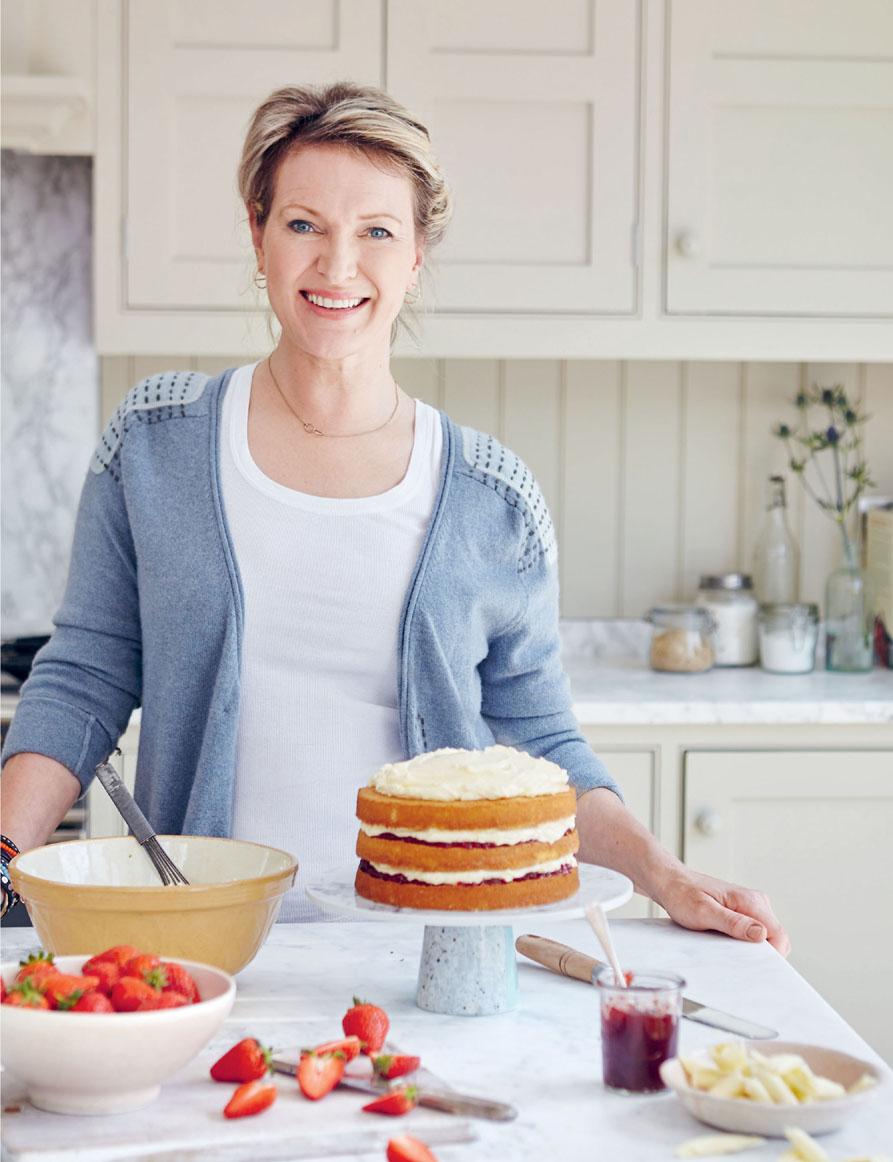
Upside-down summer berry cake
In the summer when berries are at their best, this is one of my favourite cakes to bake. There’s something so fun about cooking the berries in a pan over the hob and then just pouring the batter over the top and popping the whole thing in the oven. Turned out, the mixture of berries makes the most beautiful ready-made topping, so there’s no need to worry about icing – it’s all ready to go. Team it with cream or ice cream and it makes a brilliant dessert warm from the oven, or allow it to cool and serve a slice with a cup of tea the next day.
Serves 8
50g (1¾oz) butter
200g (7oz) caster sugar
75g (2½oz) raspberries
75g (2½oz) blueberries
75g (2½oz) strawberries, hulled and cut into halves
200g (7oz) plain flour
1 tsp baking powder
½ tsp salt
¼ tsp bicarbonate of soda (bread soda)
2 eggs
1 tsp vanilla extract
200ml (7fl oz) buttermilk
75ml (2¼fl oz) sunflower oil
softly whipped cream, to serve
25cm (10in) ovenproof frying pan
1. Preheat the oven to 180°C (350°F) Gas mark 4. Melt the butter in the ovenproof pan over a medium heat. Stir in half the sugar and cook over a gentle heat for 2 minutes. Add the fruit and set aside.
2. Sift the flour, baking powder, salt and bicarbonate of soda into a large bowl. In a separate bowl, whisk the eggs. Add the vanilla extract, the remaining sugar, the buttermilk and oil to the eggs. Mix together to combine.
3. Pour the liquid mixture into the dry ingredients and whisk to form a batter. Pour the batter over the fruit in the pan. Put the pan in the oven and bake for 30–35 minutes until the cake feels firm in the centre.
4. Leave to cool in the pan on a wire rack for 5 minutes, then turn out by putting an inverted plate over the top of the pan and turning the pan and plate over in one quick movement. Serve warm or at room temperature with cream.
Lavender and lemon cake
Light as air, this Genoise-style cake is perfumed intensely with lemon and lavender. Those refreshing flavours are just what is needed to cut through the rich, fluffy meringue frosting on the top. If you don’t have the sandwich tins specified, you can make the cake in a deep 18cm (7in) cake tin instead and slice it in half. Increase the cooking time to about 20 minutes – although the cake won’t rise as much as it would when cooked in separate tins.
Serves 8–10
25g (1oz) butter, melted and cooled, plus extra for greasing
3 large eggs
90g (3¼oz) caster sugar
zest of 2 lemons
½ tsp culinary lavender, plus extra for sprinkling
75g (2½oz) plain flour
For the candied lemons
1 small lemon, thinly sliced
150g (5½oz) caster sugar
For the meringue buttercream
2 large egg whites
120g (4¼oz) icing sugar
240g (8¾oz) unsalted butter, cut into large dice and left to soften a little
½ tsp vanilla extract
two 18cm (7in) sandwich tins
1. Make the candied lemons in advance, as they will keep for a while. Boil a pan of water and drop in the lemon slices. Blanch for 1 minute, then lift them out carefully with tongs and leave them to drain.
2. Heat 150ml (5fl oz) water in a saucepan over a medium-high heat and add the sugar. Stir until the sugar has dissolved. Drop in the lemon slices and leave them to simmer gently for 20 minutes or until the skin is softened and sweet. Remove from the syrup using tongs and leave to dry on a piece of baking parchment.
3. Preheat the oven to 180°C (350°F) Gas mark 4. Grease the sides of the tins, and line the bases with baking parchment. Pour water into a saucepan to about 4cm (1½in) deep and bring it to the boil. Put the eggs and sugar in a large heatproof glass mixing bowl. Take the pan off the heat and put the mixing bowl over the pan, making sure the base of the bowl doesn’t touch the water.
4. Using an electric beater, whisk the mixture until light and frothy. This will take 4–5 minutes, and when you lift the beaters out of the mixture, the batter dripping off the beaters should leave an impression for 3 seconds. At this point, take the bowl off the hot pan and continue whisking until the mixture is completely cold.
5. Sprinkle in the lemon zest and lavender, then sift half the flour directly over the top of the mixture. Fold in, then add half the melted butter. Repeat to add the remaining flour, then butter, folding carefully so that you don’t knock too much air out of the mixture.
6. Divide the batter evenly between the two prepared tins. Bake for 12–13 minutes until the cakes are shrinking away from the sides of the tins and are golden and firm to the touch on top. Remove from the oven and put a clean tea towel over the tins. After 5 minutes, turn them out on a wire rack and leave them to cool completely. If you aren’t decorating them immediately, wrap them in cling film once they are cool – they will go stale quickly as they don’t have much fat in them.
7. To make the meringue buttercream, prepare a saucepan of hot water as before. Put the egg whites in a clean grease-free glass bowl and sift in the icing sugar. Whisk over the hot water until you have stiff peaks. Remove from the pan and whisk until completely cold. At this point, begin to add the butter, one piece at a time, whisking in before adding the next. This will take about 5 minutes. Once you have added all the butter, whisk in the vanilla extract.
8. Spread about a quarter of the buttercream on top of one cake and put the other cake, base-side up, on top. Spread the remaining buttercream around the sides and on top of the cake. Lay the candied lemon slices on top and sprinkle with a little lavender.
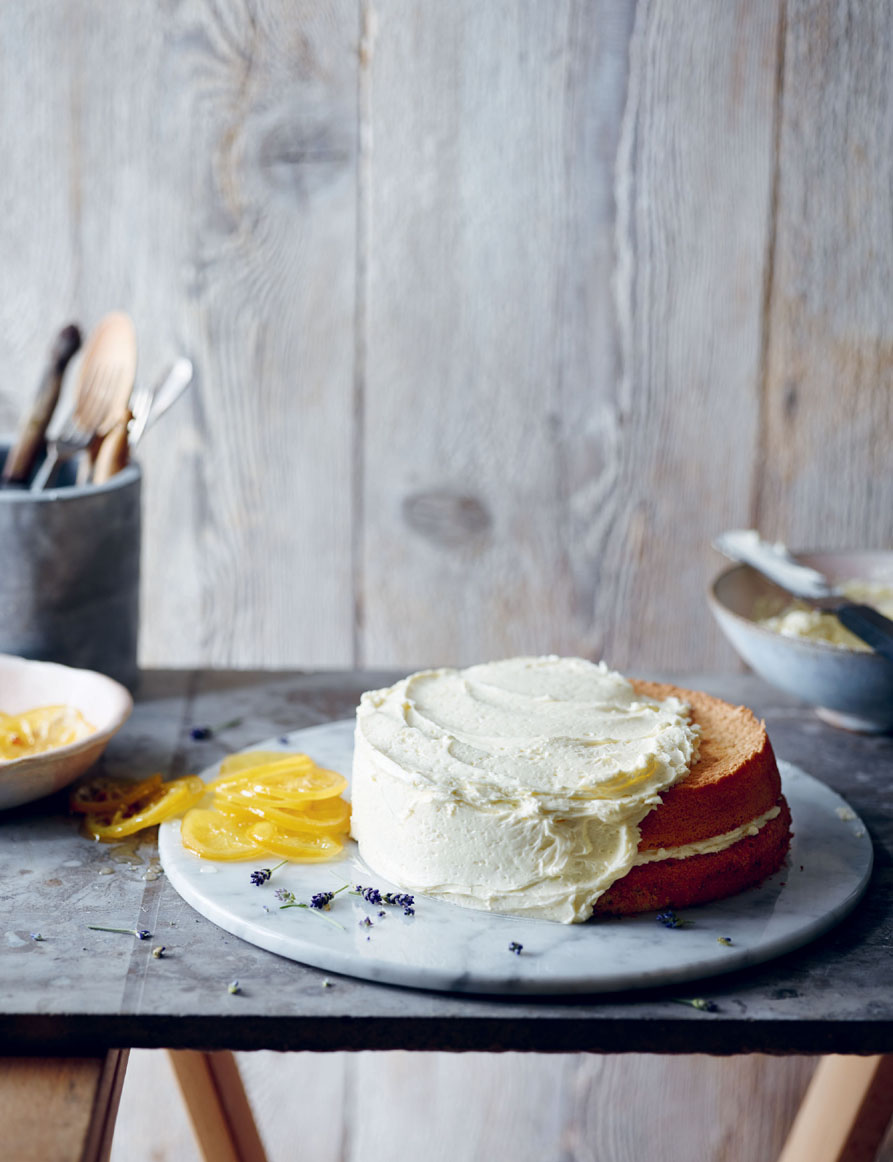

Spiced pumpkin cake with cream cheese icing
Bake this wonderful cake when the weather turns chilly and pumpkins are at their best. Warmed with gentle spices, which are contrasted against a pure cream cheese topping, this is a comforting, autumnal delight.
Serves 8
275g (10oz) pumpkin (peeled and deseeded weight), grated
175g (6oz) plain flour
2 tsp baking powder
1 tsp ground ginger
1 tsp ground cinnamon
125g (4½oz) butter, melted
200g (7oz) soft light brown sugar
2 eggs
salt
For the cream cheese icing
250g (9oz) cream cheese
250g (9oz) icing sugar
900g (2lb) loaf tin
1. Preheat the oven to 180°C (350°F) Gas mark 4. Grease and line the base and sides of the loaf tin with baking parchment. Put a double layer of kitchen paper on a large plate. Check that you have the correct amount of grated pumpkin. Spread the pumpkin over the paper on the plate and leave to stand, to remove any excess moisture, while you prepare the remaining ingredients.
2. Sift the flour, baking powder, ginger, cinnamon and a pinch of salt into a bowl. Pour the butter into another bowl and add the sugar and eggs, then whisk to combine well. Add the grated pumpkin, then pour all of this wet mixture into the dry ingredients and stir to combine.
3. Pour into the prepared loaf tin and bake in the centre of the oven for 80–90 minutes until deep golden brown and cooked in the centre and a skewer inserted into the centre comes out clean.
4. Leave to cool in the tin on a wire rack for 10 minutes. Remove from the tin and leave on the wire rack to cool completely. Remove the paper.
5. Meanwhile, to make the icing, put the cream cheese in a bowl and sift in half the icing sugar. Mix to combine, then add the remaining icing sugar and mix again. Spread over the top of the cake. Cut into slices to serve.
Smørkage
This divine treat encompasses some of my very favourite ingredients: butter, almonds cardamom and custard. Hailing from Denmark, there are many different versions of this cake, which are often enjoyed for brunch with hot coffee. Some of them are baked in a bundt tin and are then named butter ring. This is my version of the recipe and, although it does involve a few steps and a bit of time, I promise it is worth every single minute. What a treat this is – it might just be my favourite recipe in the book!
Serves 8–10
150ml (5fl oz) milk, lukewarm
50g (1¾oz) soft light brown sugar
25g (1oz) fresh yeast or 12g (½oz) active dried yeast
350g (12oz) strong white bread flour, plus extra for dusting
½ tsp salt
½ tsp ground cardamom
1 egg, beaten, plus 1 egg for the glaze
150g (5½oz) butter, cubed, plus extra for greasing
15g (½oz) almonds with skins
For the custard
250ml (9fl oz) milk
1 vanilla pod or 1 tsp vanilla extract
1 egg
50g (1¾oz) caster sugar
20g (¾oz) plain flour
For the almond paste
100g (3½oz) butter, softened
150g (5½oz) soft light brown sugar
100g (3½oz) ground almonds
6–8 drops almond extract, to taste
For the icing
150g (5½oz) icing sugar, sifted
¼ tsp ground cardamom
1–2 tbsp boiling water
23cm (9in) springform cake tin; baking tray
1. Pour the milk into a bowl, stir in the sugar and crumble in the yeast. Leave to stand for 5 minutes until creamy. Sift the flour, salt and the cardamom into the bowl of a stand mixer with a dough hook. Add the beaten egg to the yeast mixture and pour on to the dry ingredients, then mix thoroughly until combined.
2. While mixing, add the butter, bit by bit until combined. It should be springy when you press the dough with your finger. The mixture will also come away from the sides of the bowl. It will take about 10 minutes.
3. Cover the bowl with cling film and leave to rise for 1 hour or until the dough has doubled in size. (Alternatively, put it into the fridge overnight.) The dough is ready when, having pressed it with a floured finger, the dent remains.
4. Meanwhile, make the custard. Pour the milk into a saucepan over a medium-high heat and add the vanilla pod (but not the vanilla extract). Bring to just boiling, then take the pan off the heat and leave the vanilla to infuse the milk for 5 minutes. Put the egg in a bowl, add the sugar and sift in the flour, then whisk for 1 minute until light.
5. Pour the milk on to the egg mixture, whisking all the time, then add the vanilla extract, if using. Make sure that the pan is clean with no trace of burned milk, pour the mixture back into the saucepan and whisk over a medium heat until boiling, then continue whisking for 2 minutes, in which time it will also thicken a lot. Pour into a clean bowl, then leave to cool.
6. Grease the side of the tin, and line the base with baking parchment. To make the almond paste, put the butter in a bowl and cream it with a wooden spoon until soft, or use an electric beater on slow or a food processor. Add the sugar, the ground almonds and the almond extract. Mix well, then set aside.
7. Once the dough is ready, tip it out of the bowl on to a floured work surface. Cut off one-third of the dough and cover the remaining dough with a clean tea towel. Roll the small piece of dough into a 25cm (10in) circle and put it into the base of the tin. Spread about 3 tablespoons of the almond paste over the dough to cover it, then top it with the custard, forming an even layer.
8. Roll out the remaining dough to a 28 × 40cm (11¼ × 16in) rectangle. Cover this with the remaining almond paste, then roll it up from the long side. Cut the roll evenly into 8 slices. Put one slice in the centre of the custard layer, cut-side up, then put the remaining swirls around the edge.
9. Cover the tin with cling film and leave to rise for 45 minutes or until light, puffy and doubled in size; when you gently press some dough with a floured finger the dent should remain. Preheat the oven to 180°C (350°F) Gas mark 4.
10. Beat the remaining egg with a pinch of salt and use to brush the cake, then bake for 30 minutes. Reduce the oven temperature to 160°C (315°F) Gas mark 2½ and bake for 20 minutes or until golden brown. Take the cake out of the oven and leave the oven on. Put the almonds on the baking tray and roast for 8–10 minutes until golden. Leave to cool.
11. Leave the cake in the tin on a wire rack to cool for 20 minutes, covered with a clean tea towel, then carefully run a small, sharp knife around the edges to free the cake from the tin, and unclip the sides. Turn it upside down to remove the tin base and the paper, then put it on a serving plate to finish cooling. Slice the cooled almonds coarsely.
12. To make the icing, sift the icing sugar and cardamom into a bowl. Add enough boiling water to make an icing the consistency of thick fresh double cream. Once the cake is cool, drizzle the icing backwards and forwards over the top of the cake in a zigzag pattern, then immediately scatter the toasted almonds over the top. Serve.
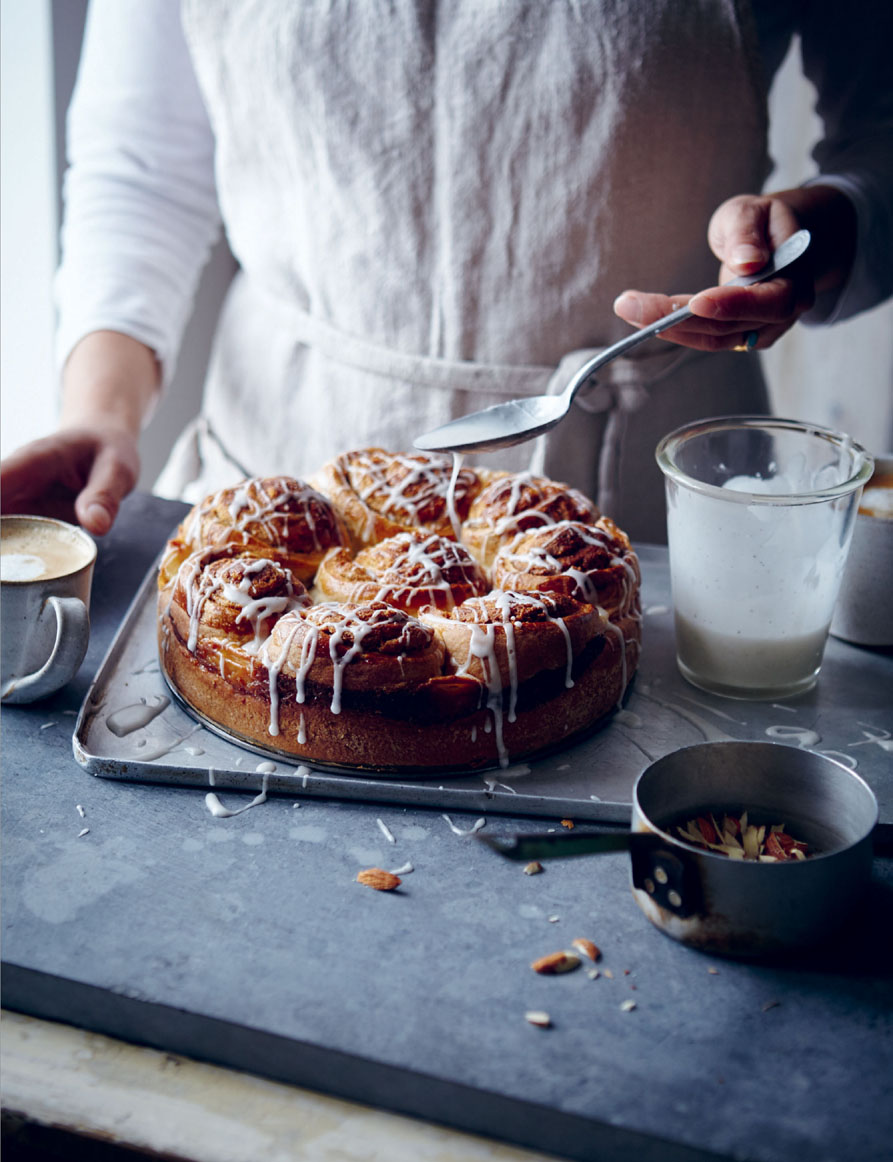
Coffee and cardamom cake
I absolutely adore cardamom, and there’s something about its aromatic, smoky flavour that goes so well with coffee. I have paired them here in this luxurious cake, finished with a creamy mascarpone icing and toasted pistachio nuts.
Serves 8–10
175g (6oz) butter, softened, plus extra for greasing
175g (6oz) plain flour
175g (6oz) caster sugar
3 eggs, beaten
1 tsp ground cardamom
1 tsp baking powder
1 tbsp instant coffee powder
25g (1oz) pistachio nuts, toasted and chopped
For the coffee icing
250g (9oz) mascarpone
3 tbsp icing sugar
2 tsp instant coffee powder
two 18cm (7in) cake tins
1. Preheat the oven to 180°C (350°F) Gas mark 4. Grease the base and sides of the tins, and dust the sides lightly with flour, then line the bases with baking parchment. Put the butter in a large bowl and cream it with a wooden spoon until soft, or use an electric beater on slow or a food processor. Add the sugar and beat until the mixture is light and fluffy. Gradually add the eggs to the creamed mixture, beating constantly. Sift in the flour, cardamom, baking powder and coffee powder, and fold in gently to mix.
2. Divide the batter between the two prepared tins, making a slight hollow in the centres so that the cakes will rise with a flat top. Bake for 20 minutes or until well risen, golden brown and springy to the touch.
3. Remove from the tins and leave on a wire rack to cool completely. Meanwhile, to make the icing, put the mascarpone in a bowl and sift in the icing sugar and coffee powder, then mix well to combine.
4. Put one of the cakes upside down on a plate, then spread over half the icing. Put the other cake, right-side up, on top of the filling, then spread with the remaining icing. Scatter the toasted pistachio nuts over the top.
Gingerbread cake with raspberries
Based on a classic Victoria sponge, this beautiful cake has the added twist of warm spices. It makes a great layered cake for an occasion, piled high with sweet summer raspberries.
Serves 8
175g (6oz) butter, softened, plus extra for greasing
175g (6oz) plain flour, plus extra for dusting
175g (6oz) soft light brown sugar
3 eggs, lightly beaten
1 tsp baking powder
1 tsp ground cinnamon
1 tsp ground ginger
a pinch of ground cloves
¼ tsp ground cardamom
1 tbsp milk
125g (4½oz) raspberries
For the icing
125g (4½oz) butter, softened
125g (4½oz) cream cheese
275g (10oz) icing sugar
125g (4½oz) raspberries
two 18cm (7in) sandwich tins
1. Preheat the oven to 180°C (350°F) Gas mark 4. Grease the sides of the tins, and dust lightly with flour, then line the bases with baking parchment. Put the butter in a large bowl and cream it with a wooden spoon until soft, or use an electric beater on slow or a food processor. Add the sugar and beat until the mixture is light and fluffy.
2. Gradually add the eggs to the butter mixture, beating constantly. Sift in the flour with the baking powder, cinnamon, ginger, cloves and cardamom. Add the milk and fold in gently to mix.
3. Divide the mixture between the prepared tins and bake for 18–25 minutes, until golden on top and springy to the touch. Leave to cool in the tins on a wire rack for 10 minutes, then loosen around the edge of each cake using a small, sharp knife and carefully remove them from the tins. Leave the cakes on a wire rack to cool completely.
4. To make the icing, put the butter in a bowl or a food processor and add the cream cheese and icing sugar. Cream, or beat, until well combined and soft. Add the raspberries and gently mix together until incorporated.
5. Spread half the icing over the top of one cake and put the other cake on top. Spread the remaining icing on top of the cake. Decorate the iced cake with the raspberries, then serve.
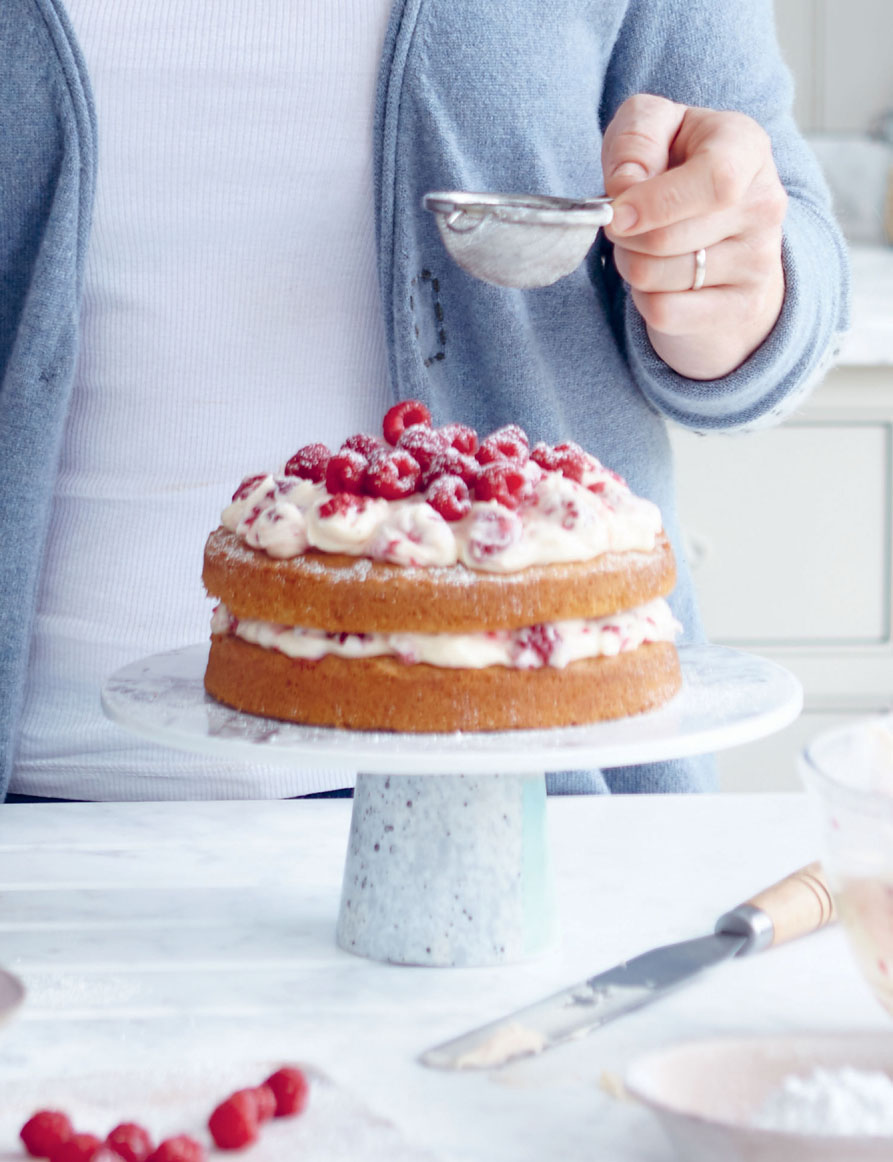
Orange kugelhopf
I love my kugelhopf baking tin – it makes such grand, stately-looking cakes with very little effort! But, even if you don’t have one, don’t let that put you off trying this delicious orangey cake, because a 23cm (9in) springform cake tin will make a perfectly lovely cake, too. Drizzled with icing and sprinkled with pistachio nuts, it makes a great celebration cake.
Serves 10–12
225ml (8fl oz) sunflower oil, plus extra for greasing
325g (11½oz) plain flour, plus extra for dusting
1½ tsp baking powder
1½ tsp salt
400g (14oz) caster sugar
4 eggs
325ml (11½fl oz) milk
zest of 1 orange
25g (1oz) pistachio nuts, lightly toasted and chopped
For the icing
125ml (4½fl oz) crème fraîche
100g (3½oz) icing sugar, sifted
zest of 1 orange
23cm (9in) bundt tin or a 23cm (9in) cake tin with at least 4cm (1½in) sides
1. Preheat the oven to 180°C (350°F) Gas mark 4. Grease the bundt tin and dust with flour. (If using a cake tin, grease the side of the tin and line the base with baking parchment.) Sift the flour, baking powder and salt into a large bowl, add the sugar and mix together.
2. In a separate bowl, whisk together the eggs, milk and orange zest until combined. Whisk in the oil, tip this mixture into the dry ingredients and mix together using a wooden spoon to make a smooth batter. You may need to use a whisk briefly to remove any lumps of flour.
3. Tip into the prepared tin and bake for 50–60 minutes (or 60–70 minutes if using a cake tin) until the cake feels springy to the touch and a skewer inserted into the centre comes out clean.
4. Leave in the tin on a wire rack for 2 minutes, then run a knife around the edge of the tin and carefully remove the cake from the tin. Leave on the rack to cool completely, then remove the paper.
5. Meanwhile, make the icing. Put the crème fraîche in a bowl and sift in the icing sugar, then mix to combine. Add the orange zest and stir to combine.
6. Put the cake on a serving plate or cake stand. Drizzle the icing backwards and forwards from the centre to the outside of the cake in a zigzag pattern. Sprinkle over the pistachio nuts and serve.
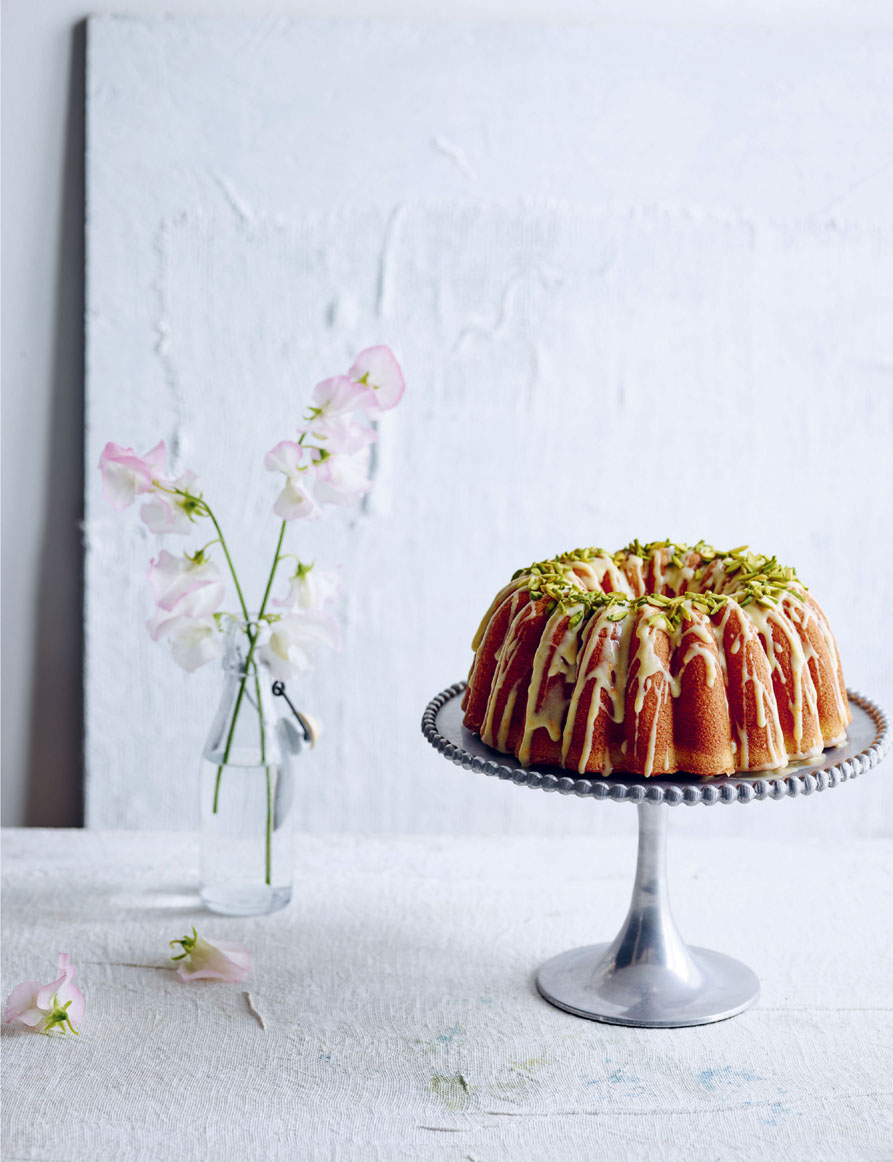
Polenta, orange and pistachio cake with orange syrup
This gluten-free dessert is great for summer entertaining. Serve a slice on its own for a casual tea in the garden or add a good dollop of crème fraîche for a delicious dinner-party dessert. The syrup makes it so moist that you can prepare the cake in advance without the worry of it tasting stale.
Serves 8
225g (8oz) butter, softened, plus extra for greasing
125g (4½oz) polenta, plus ½ tbsp for dusting
225g (8oz) caster sugar
3 eggs
zest of 1 orange and juice of ½ orange
50g (1¾oz) pistachio nuts, roughly chopped
200g (7oz) ground almonds
1 tsp baking powder
25 pistachio nuts, lightly toasted and roughly chopped
For the orange syrup
75g (2½oz) caster sugar juice of 1 orange
20cm (8in) springform cake tin with a high side
1. Preheat the oven to 170°C (325°F) Gas mark 3. Grease the side of the tin, and line the base with baking parchment. Dust the side of the tin with the ½ tablespoon polenta. Put the butter in a large bowl and cream it with a wooden spoon until soft, or use an electric beater on slow or a food processor.










